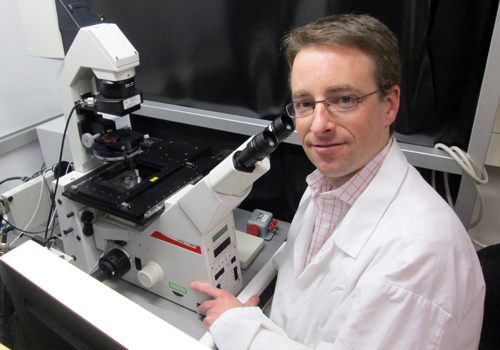
Starting a new job can be a nerve-racking experience, but Prof. John Vessey finds himself in good company. Vessey is among four new faculty who joined the Department of Molecular and Cellular Biology in 2013. He says he was drawn to the diversity of research conducted within the department and with other departments on campus.
“I’m very attracted to the fact that there’s a vet school across the street, which offers me a lot of opportunities for collaboration,” he says. As a neuroscientist, he looks forward to working with other neuroscientists at the Ontario Veterinary College, including cellular, molecular and stem cell biologists.
Before joining U of G, Vessey held a post-doc at the Hospital for Sick Children in Toronto, where he studied neural stem cells. “I’m interested in brain development,” he says. “I’m interested in how the stem cells of the developing brain go about producing both the neurons and glia that end up forming the complex organ that is our brain.”
Vessey studies embryonic brain development, which happens both before and after birth. He’s interested in learning how a brain stem cell divides asymmetrically into two types of cells: one remains a stem cell while the other becomes a neuron or glia. He says ribonucleic acid (RNA) localization is responsible for determining what type of cell it will become. If the daughter cell inherits certain RNA, it becomes a neuron; if not, it remains a stem cell.
Vessey explains that RNA localization was first discovered in fruit fly embryos. As the fly embryo develops, RNA localizes in one end of the embryo, leading an axis to form along which the body plan is established. Scientists later found that in rodents and humans, “RNA localization is one way that neurons establish their polarity and promote their function,” he says. “If you disrupt RNA localization in neurons, you often inhibit the ability for synaptic plasticity to occur, which is the fundamental sub-cellular mechanism for learning and memory.” Some of the genes responsible for RNA localization in fruit flies perform the same function in mammalian neurons and, as Vessey recently discovered, in embryonic brain development, by directing the cell to become a neuron or not.
He says many diseases that affect the brain can be traced back to a defective X chromosome. These types of diseases are more likely to affect males, as they have only one X chromosome. “Even if the gene is a recessive gene, we only inherit one, so that leaves us more susceptible to its effects.” Some genes important for RNA localization are found on the X chromosome and have been implicated in certain cognitive impairments. Other conditions, such as autism spectrum disorder, are believed to be caused by a mutation or deregulation of many neural stem cell genes. Vessey’s research will explore the genetic causes of autism and other neurological conditions that originate at the embryonic stage.
“Understanding the disease process is probably the most immediate impact of my research,” he says. That could lead to better treatments based on new drug targets, signalling pathways or genetic testing.
As an undergrad at Dalhousie University, Vessey was interested in cell biology. “I had always pictured cells as these spherical round things,” he says. That changed when he took an introductory neuroscience course and began studying “the extremely complex morphology of neurons.” He wanted to learn how these cells formed, functioned and worked together.
After he graduated, he worked as a technician in a lab studying prostate cancer. Although he enjoyed working there, he says, “I wanted to get back into the brain.” He did his master’s degree with a Dalhousie professor who studied the retina.
What’s the connection between the eye and the brain? “The reason why I studied photoreceptors is because they’re the sensory neuron of the eye, and the retina is a very accessible piece of brain tissue,” says Vessey. “It’s the only part of your brain that you can see.” Signals from these photoreceptors travel to bipolar cells, which transmit them to neurons in the brain.
Having joined U of G in September, he will spend the next several months setting up his lab and preparing for his first class of students this fall. He hopes to inspire them in the same way his own mentors inspired him throughout his academic career. “I look forward to imparting that enthusiasm onto my future graduate students,” he says, “and inspiring them to become good scientists.”